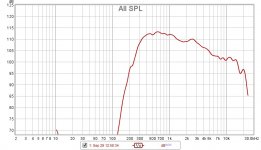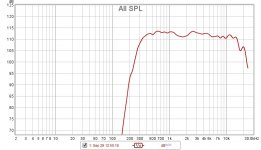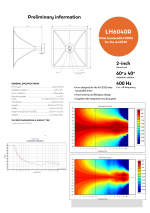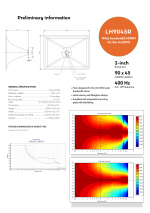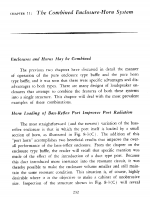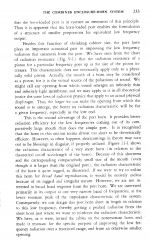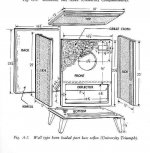Axi 2050
Been reading this thread and conversing privately with Ro808 and Camplo amongst others.
Had originally looked at BMS4594HE and then B&C DCX464 but then hit on very lucky to get the Axi 2050 at a good price so went for it. The plots Camplo has been posting are mine and I have finally got round to posting here myself.
These are some plots I have just done today with the Axi on a 200Hz JMLC with mic on axis at 35cm from horn mouth. There is a plot with no filters and then one with a couple of high shelves to get it to play higher. It can be made to be 6 or 7 dB down at 20k but most of that is a sharp dive at 16k. Not really sure if I should be bothered about that, I don't want to use too much eq on it. The shelves don't seem to affect the sound adversely but using peq filters makes it sound sat on and unnatural. What is the accepted response at 20k? I have seen various figures quoted from flat to a gradual slope from 1K to 20k with either 3dB, 6dB or 10dB reduction at 20k?
The lower end response is ok to 300Hz but don't know if it can be made to play lower on this horn? These plots are with a high pass filter at 200Hz, 48 dB per octave. I use a Najda DSP digital crossover. I currently have a crossover at 330Hz to a Fane Colossus 18XB in a U-frame open baffle. Below the Fane I have an active sub from 55Hz down.
Been reading this thread and conversing privately with Ro808 and Camplo amongst others.
Had originally looked at BMS4594HE and then B&C DCX464 but then hit on very lucky to get the Axi 2050 at a good price so went for it. The plots Camplo has been posting are mine and I have finally got round to posting here myself.
These are some plots I have just done today with the Axi on a 200Hz JMLC with mic on axis at 35cm from horn mouth. There is a plot with no filters and then one with a couple of high shelves to get it to play higher. It can be made to be 6 or 7 dB down at 20k but most of that is a sharp dive at 16k. Not really sure if I should be bothered about that, I don't want to use too much eq on it. The shelves don't seem to affect the sound adversely but using peq filters makes it sound sat on and unnatural. What is the accepted response at 20k? I have seen various figures quoted from flat to a gradual slope from 1K to 20k with either 3dB, 6dB or 10dB reduction at 20k?
The lower end response is ok to 300Hz but don't know if it can be made to play lower on this horn? These plots are with a high pass filter at 200Hz, 48 dB per octave. I use a Najda DSP digital crossover. I currently have a crossover at 330Hz to a Fane Colossus 18XB in a U-frame open baffle. Below the Fane I have an active sub from 55Hz down.
Attachments
Hi Keith. Thanks for the plots and the info. That's a big help and puts things into perspective. Helps fill in the picture, so to speak 

These plots are with a high pass filter at 200Hz, 48 dB per octave. .
Well theres one piece of info I was looking for. I'd very much like to see a measurement taken with the high pass at 100hz Or without a high pass filter, just start the the measurement at 200hz. That will answer a lot of questions about what the driver can do and what the horn needs to do at that side of the register, please and thank you for taking the time to share this info!
Last edited:
If the sweeps are done at very low levels with the mic close, then low frequencies aren't a problem. However they might not give a good picture of distortion at higher levels.
I can do another measurement as suggested but I did do one with a high pass at 150Hz and there was no difference to the curve from at least -6dB and above. I didn't pursue it as I attributed that result to the horn.
I think with this driver on a 100Hz JMLC may get the 200Hz response of the OP but may compromise the upper frequencies further.
Subjectively I am really very happy with the horn/driver combo. The 18" sounds fine up to 330Hz (Will experiment to see if I can get it lower) and the Axi seems happy with that also. The big win for me is getting from 300Hz-ish to over 15kHz on one driver and horn.
BTW the horns were not expensive cf some of the competition and more might be possible with a 100Hz Horn and more dsp for the higher frequency response.
The red horn that is seen in the YouTube videos was designed by Bjorn Kolbrek and was at the European Triode Festival last year. From what I have heard that horn is going to be a production item and cost the same as an Axi2050 per horn. There may be more available from this driver on that horn if you can afford it.
I think with this driver on a 100Hz JMLC may get the 200Hz response of the OP but may compromise the upper frequencies further.
Subjectively I am really very happy with the horn/driver combo. The 18" sounds fine up to 330Hz (Will experiment to see if I can get it lower) and the Axi seems happy with that also. The big win for me is getting from 300Hz-ish to over 15kHz on one driver and horn.
BTW the horns were not expensive cf some of the competition and more might be possible with a 100Hz Horn and more dsp for the higher frequency response.
The red horn that is seen in the YouTube videos was designed by Bjorn Kolbrek and was at the European Triode Festival last year. From what I have heard that horn is going to be a production item and cost the same as an Axi2050 per horn. There may be more available from this driver on that horn if you can afford it.
@keith1962 - very nice! If you take more measurements, would be great to see some off-axis plots as well.
Last edited:
That will answer a lot of questions about what the driver can do and what the horn needs to do at that side of the register
The horn sets the driver's limits, so sheer size sets your lowest high enough gain XO point, i.e. look at the W.E. big expo horns that loaded nominally flat from 100-5 kHz/~9 deg off axis with a 1" driver.
GM
Yes, for the lowest possible cutoff an expo horn is required. It has to be very deep - unless bended, with a hugh mouth circumference and WITHOUT roll back.
Here's where my idea enters the picture 😉, which is still an illusionary concept, albeit based on the works of one of the 'great minds'.
The (not so) big red Axi2050 horns are exponential as well, but still won't provide enough loading to the driver below 400Hz.
Here's where my idea enters the picture 😉, which is still an illusionary concept, albeit based on the works of one of the 'great minds'.
The (not so) big red Axi2050 horns are exponential as well, but still won't provide enough loading to the driver below 400Hz.
Attachments
Last edited:
Here's his other - well known - work.
Thanks!
My 'bible' 😉 and now that it's in the public domain, may I direct ya'll to pg. 242 with its various acceptable room ratios one should ideally use when configuring horn mouth ratios [or calculate your own], though FWIW the pioneers had a 1:1.273 limit for ~ same speech intelligibility as its round equivalent: HI-FI Loudspeakers and Enclosures, Abraham B. Cohen pg. 236 [couldn't find an ebook or Chapter 11 or at least its chart on-line]
GM
Yes, for the lowest possible cutoff an expo horn is required. It's going to to be very deep - unless bended, and with a large mouth circumference WITHOUT roll back.
Actually it's hyperbolic as it's the only flare that can do a max BW reactance annulled alignment.
Right, even the biggest W.E. horns are truncated, so was debating whether to waste my time suggesting W.E.'s original folded horn except with 180 deg round over to create the woofer's baffle in basically a false wall stereo system.
But what about when doing HT? Haven't noticed any consideration of size limitation for an LCR mains system at the THX 60 deg included angle.
GM
Actually it's hyperbolic as it's the only flare that can do a max BW reactance annulled alignment.
GM

 Exactly!!
Exactly!!Thanks!
My 'bible' 😉 and now that it's in the public domain, may I direct ya'll to pg. 242 with its various acceptable room ratios one should ideally use when configuring horn mouth ratios [or calculate your own], though FWIW the pioneers had a 1:1.273 limit for ~ same speech intelligibility as its round equivalent: HI-FI Loudspeakers and Enclosures, Abraham B. Cohen pg. 236 [couldn't find an ebook or Chapter 11 or at least its chart on-line]
GM
The book is available, but many chapters are missing, including Ch.11.
What's the title of that chapter?
What is the accepted response at 20k? I have seen various figures quoted from flat to a gradual slope from 1K to 20k with either 3dB, 6dB or 10dB reduction at 20k?
Those desired responses are an averaged in room response. With a constant directivity device the on axis response will be very similar to the room response and will have a similar sloping profile. With a non CD device like yours it will be trial and error to get you to a decent target response. The sound coming in from the room will have a very different spectral balance to the on axis response. Try some different target curves until you find one that sounds balanced. I struggled to find balance with a JMLC horn.
Also unless you are still in your early 20's (Which I doubt looking at your user name) having the response fall away beyond 10KHz is no problem.
Last edited:
Sooooo, can I have a deep horn, the length of the 200hz, and retain the smaller opening diameter, to help match polars with my woofers?
It sounded like depth was the main factor in horn loading and maybe the mouth played a smaller part.
It sounded like depth was the main factor in horn loading and maybe the mouth played a smaller part.
Last edited:
Although this man's testosterone regularly seems to end up in the wrong place (between his ears), he has a point regarding JMLC versus Tractrix horns.
The rest is out somewhere, but I can't grab it.
'HORN-TYPE ENCLOSURES'
The rest is out somewhere, but I can't grab it.
Attachments
Although this man's testosterone regularly seems to end up in the wrong place (between his ears), he has a point regarding JMLC versus Tractrix horns.
Its funny that should post this, as I was reading this article about an hour ago....for the second time in about a month, but non the less, his comments about the jmlc curve creating more baffle area makes sense, and too me, makes the jmlc, still desirable though not exactly necessary.
- Home
- Loudspeakers
- Multi-Way
- Is it possible to cover the whole spectrum, high SPL, low distortion with a 2-way?
